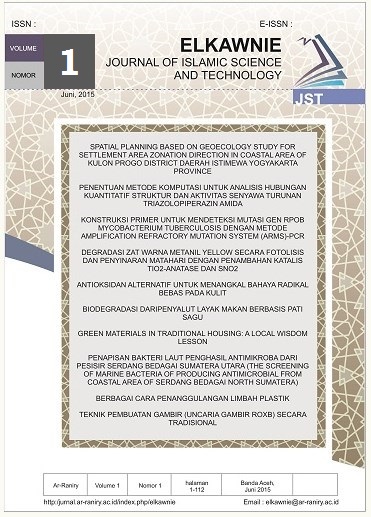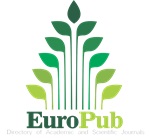Konstruksi Primer Untuk Mendeteksi Mutasi Gen rpoB Mycobacterium tuberculosis Dengan Metode Amplification Refractory Mutation System (ARMS)-PCR
DOI:
https://doi.org/10.22373/ekw.v%25vi%25i.516Keywords:
mutasi, M. tuberculosis, ARMS-PCR.Abstract
Quickly recognize drug resistance in Mycobacterium tuberculosis is very important for the efficiency of the treatment and control of the disease. More than 95% of RIF resistance occurs due to point mutations in the 81-bp region of the rpoB gene M. tuberculosis. Generally, the mutation occurs at codon 531, 526 and 516. One of method to detect the mutation is using ARMS-PCR. In order to apply the ARMS-PCR technique to detection of mutations needed a special and specific primer. Primer design process using computer software "Primer Designer" and the specificity was confirmed with "Bioedit". Accuracy and ability of all these primers to detecting mutation in rpoB gene M. tuberculosis tested using ARMS-PCR method. PCR amplification results were then analyzed using the techniques of electrophoresis on agarose 1.5%. Electrophoresis results showed two bands produced from the amplification with the template H37RV (wild type). Both bands are expected to be in a position 238 bp and 484 bp, in the other hand the result amplification with the template from mutant strains produce one band with sized 484 bp. From these data it is known that ARMS-PCR reactions are performed can be used to detect mutations in the rpoB gene of M. Tuberculosis.References
WHO. 2015. Global Health Observatory (GHO) data http://www.
who.int/gho/data Diakses 3 agustus 2015
] Rumah Sakit Prof. Sulianti Saroso (www.infeksi.com). 2007.
Pusat Informasi Penyakit Khususnya HIV AIDS. Jakarta. Diakses
Maret 2008.
] Kementerian Kesehatan Republik Indonesia. 2011. Strategi
Nasional Pengendalian TB di Indonesia 2010-2014. Jakarta
] WHO. 2005. Guidelines for Surveilance of Drug Resistant in
Tuberculosis. Geneva
] Gillespie, SH. 2002. Evolution of drug resistance in Mycobacterium
tuberculosis. Clinical and molecular perspective. Antimicrobial
Agens and Chemotherapy. (Vol.46. No.2, 2002)
] Crofton,J.N., Horne and Miller. 2002. Clinical Tuberculosis.
McMilan education. London.
] Johnson, R. et al. 2005. Drug resistance in Mycobacterium
tuberculosis. Cuur Issue molecular Biology. (vol.8, 2005)
] Deepa, P., K. L. Therese and H. N. Madhavan. 2005. Detection
and Characterization of mutations in rifampicin reisstance
Mycobacterium tuberculosis clinic isolates by DNA sequencing.
Indian Joumal of Tuberculosis. (vol.52, 2005).
] Musser, J. M. 1995. Antimicrobial Agent resistance in Mycobactria:
Molecular Genetic Insights. Clinical microbial reviews. Hal 496 –
] Victor, TC et al. 1999. Detection of mutation in drug resistance
genes of Mycobacterium tuberculosis by a dot-blot hybridization
strategy. Tuberculosis and Lung Disease. (vol.79, 2009) Hal 343348
] National Center for Biotechnology Information, U.S. National
Library of Medicine. rpoB gene [Mycobacterium tuberculosis];
Available at: http://www.ncbi.nlm.nih.gov. Diakses 4 maret
] Victor, TC et al. Standard Operation Procedure. (Tidak
dipublikasikan)
] Sambrook, J and Russel. 2001. Molecular cloning, A laboratory
Manual 3rd edition. Cold Sprig Harbour Laboratory Press. New
York
Dieffenbach CW, Dveksler GS, editors. 2003. PCR primer: a
laboratory manual. 2nd edition. Cold Spring Harbor Laboratory
Press. New York
] Yuwono, T. 2006. Teori dan aplikasi Polymerase Chain Reaction.
Andi. Yogyakarta
] Fatchiyah, dkk. 2008. Analisa Biologi Molekuler. Jurusan Biologi
Universitas Brawijaya. Malang
] Hanegariu, O. et.al. 1997. Multiplex PCR: Critical Parameters and
Step-by-Step Protocol. Bio Techniques. (vol.23, 1997)
] Rybicki, et.al. 2001. PCR Primer Design and Reaction
Optimisation. University of Cape town. Cape town
] Yuryev, A. 2008. PCR Primer Design. Tontowa J. Humana Press.
] Fermentas. 2008. Standard Protocol for PCR. Fermentas Lincoln
|
centre Drive. California.
Downloads
Issue
Section
License
Proposed Policy for Journals That Offer Open Access Authors who publish with the Elkawnie journal agree to the following terms:
a. Authors retain copyright and grant the journal right of first publication with the work simultaneously licensed under a Creative Commons Attribution License that allows others to share the work with an acknowledgement of the work's authorship and initial publication in this journal.
b. Authors are able to enter into separate, additional contractual arrangements for the non-exclusive distribution of the journal's published version of the work (e.g., post it to an institutional repository or publish it in a book), with an acknowledgement of its initial publication in this journal.
c. Authors are permitted and encouraged to post their work online (e.g., in institutional repositories or on their website) prior to and during the submission process, as it can lead to productive exchanges, as well as earlier and greater citation of published work (see The Effect of Open Access).

























